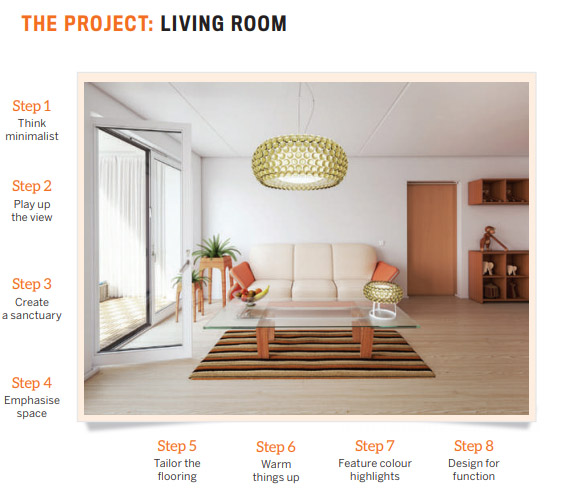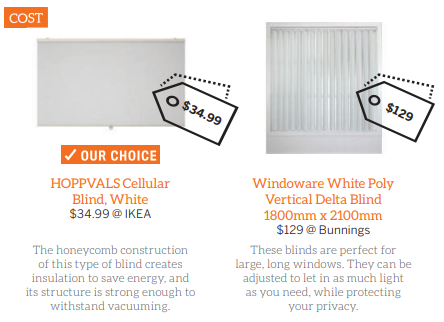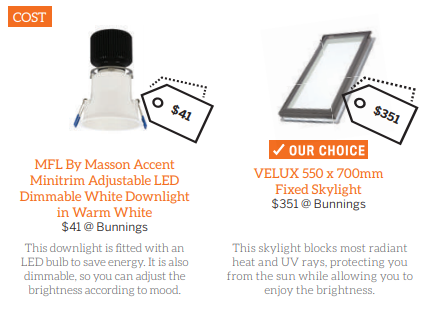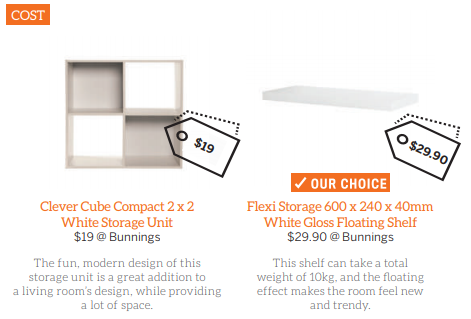08/01/2019
The living room is the heart of every house. It’s where the family gathers to munch down on popcorn while watching a movie, and where everyone mingles for celebrations – it is the central ‘living’ hub of a home.

Without a good functional living space, a house becomes lifeless. Cramped areas, lack of natural light and tangled hallways can all make a space feel suffocating, and a suffocating feeling certainly does not equal bang for your buck.
“The configuration of a house is everything. It’s about opening up pokey hallways and embracing an open-plan living style so that your future buyer or tenant can enjoy the space. Space is perceived value; everyone wants space, and they are willing to pay for it,” explains Jane Slack-Smith from The Ultimate Guide to Renovation.
“A key part of a successful strategic renovation is adding perceived value, meaning spending money in the places where it can be seen – and where better than the communal living areas?”
Renovating a living space is about creating space and the illusion of space, given what you have. Slack-Smith provides the following tips on how to upgrade your living areas.
Step one: Think minimalist
A simple colour scheme is a smart way to go, especially if you intend to sell or rent the home. This allows buyers or tenants to easily envision where they can be creative, warming them to the property.

Keep your design simple so your buyer can decorate the property to their own style. Neutral means the property will appeal to more people.
To add depth to your living room, contrasting classic shades of charcoal, grey or taupe work well. This keeps it from looking uninspired, while maintaining a clean aesthetic.
Top tip
Opt for neutral colour schemes and add colour with finishings or even window coverings that can easily be changed. Don’t add ‘trending now’ colours as they will date quickly.

If your living room overlooks your backyard, maximise the view by installing a fl oor-to-ceiling window, if your building allows for it.
The openness creates an illusion of space to widen the room, and lets a lot of natural light in to make it more airy and attractive. You can also install a sliding glass door for easy access to the yard.
Large windows can also serve the dual purpose of security if families are among your potential buyers, as parents will then be able to keep an eye on their children playing outdoors while remaining inside the house.
Top tip
Windows are beautiful but require regular maintenance to keep their aesthetic appeal. Use a cloth and soapy water to wipe down the glass, or a non-abrasive cleaner that won’t leave unsightly marks.
Step three: Create a sanctuary
You may do a lot of entertaining in the living room, but that certainly doesn’t mean that everyone gets a free pass to look into your space.
Consider low-maintenance blinds, whether you’re renovating your own home or a rental property. This is where you can add a little colour – a charcoal colour looks great in a neutral colour scheme.
Cellular blinds are easy to maintain as they have anti-static properties and repel dust, which means they look clean even if you don’t wipe them down regularly. Vertical blinds are another terrific option – it’s hard for dust to cling on, given their positioning.

Top tip
PVC or faux wood blinds can be cleaned with just a feather duster or a damp cloth because their surfaces keep dirt from settling. In a home with children, you can also opt for cordless blinds to avoid accidents and be compliant with regulations.
Step four: Emphasise space
A great way to create the illusion of space is to make the ceiling seem taller through the use of lighting.
When thinking of large open spaces, we think of light. This could be a skylight, or a suspended ceiling with lights. But if you want to emphasise natural light, skylights are the way to go – they also add an attractive design feature by giving the room a connection to the outdoor environment.
You can install recessed lights in the ceiling for night-time. Yellow lights create a warm glow that gives the room a homey atmosphere.
Top tip
Lay out your lights so that they complement each other – small, unobtrusive down lights around the border of the skylight frame keep the focus on the skylight. Ensure that the skylight is made of tough material.

Functionally, it may just be a surface to step on, but flooring is a critical design element of any room. You need to know what atmosphere you want to generate and the audience you want to cater to, in order to select the right kind of floor.
For instance, if it is a young professional couple or a family with children, then perhaps avoid soft timber polished floorboards that can be damaged by high heels or toys.
As a less fragile alternative, you can opt for tiles that emulate the appearance of wood or stone, achieving a classy effect at a lower cost.
Step six: Warm things up
A beautiful fireplace can add oomph to the living room and serve as a centrepiece, enabling you to design the room around that one piece.
You can have a fireplace custom-made to your living room’s specifications. There are many options that don’t require you to have a chimney, such as burner only, gas and electric fireplaces. However, you can also go for indoor wood heaters recessed into the wall to create space and generate a modern feel.
If you’re aiming for a traditional look, a fireplace with a mantelpiece not only evokes that old-world feel but also provides additional shelf space.
Top tip
Stone fireplaces instantly turn a living room into a high-class space. The austere effect can be scaled down with personal items on the mantle, such as photos, books and other knickknacks.
Step seven: Feature colour highlights
You can incorporate colour and pop COST into a minimalist room at low cost by adding a feature wall to act as the main design element of the room.

Many feature walls create looks that contrast with the rest of the space magnificently, keeping all eyes on that one aesthetic. However, you need to be careful not to work with colours that are too ‘out there’.
Feature walls can really date a property – I remember that a purple feature wall that I added quickly dated an area that was clean and light and modern.
Stick with a neutral philosophy and the result will be sure to have broad appeal.
Top tip
Keep to a neutral colour scheme with flexibility to suit different residents. In dark corridors and halls, use the wall colour at half strength to lighten up the space.
Step eight: Design for function
Make space matter by creating a COST lot of storage and display options, enhancing the appeal of the property for future residents.
It is always easy to show how thoughtful you are with your design of this space. Consider a homework nook or fold-out desk, built-in bookcases or mountings for large TVs. Get to know your renter or buyer by looking at other renovated properties in the area, and add that little bit extra.
There are many affordable ways to add function to a living room, such as wall shelves, console tables and cube storage units.
Top tip
Storage baskets are a smart way to utilise all that extra space under furniture. Go for plainly designed baskets and boxes that will pair effectively with the room without drawing a lot of attention.
CASE STUDY
Jodie Moore’s first-ever official renovation saw her rely on her gut instincts when turning her two-bedroom Adelaide Hills cottage into a three-bedroom leafy sanctuary – driving a six-figure profit along the way.

Jodie Moore purchased her charming two-bedroom cottage in 2008 after deciding that she wanted to try her hand at a full-blown renovation.
“I’d developed several properties before and most recently finished an owner-build construction. This time I wanted to try something different,” she says.
Cost was important to Jodie – at the time, she was doing the renovation alone while raising two children. She used recycled materials wherever she could and sourced items such as timber, tiles and fittings from auction houses and Gumtree.
“I didn’t actually have a specified budget for the house. The budget was – get whatever I need for as close to zero as possible.”
Jodie’s cottage was a multi-era development, with original parts of the house dating back over 100 years. The original 1860s part of the house was built in the traditional method using mud and straw, so when Jodie removed the wall she exposed the dirt and straw that had been used over 100 years ago. Keeping with the historic feel of the home was important to Jodie, but she also wanted to find a way to modernise the property.
The cottage was on a large block with a stunning view of the Adelaide Hills. Jodie opted to embrace the space and opened up the existing kitchen wall to lead into the living area.
“A key part of a successful strategic renovation is spending money in the places where it can be seen, and where better than the communal living areas?”
“I was standing out in the backyard one day, admiring the aspect, and wanted to find a way to bring all of it into the house. It was in this moment I grabbed a sledgehammer and knocked out the back wall to get started!”
This open-plan design capitalised on the glorious backyard and outdoor sanctuary Jodie had designed. It created a flow design from the indoors to the outdoors, making even more use of the space. She kept the historic feel at the front of the house and slowly phased in a more modern design as the home transitioned into the new extension where the living room is located.“Contrary to what all the experts say, I actually renovated this property with my heart and my intuition – luckily, I was right on trend with what the market wanted!”
Jane Slack-Smith is a bestselling author,
media commentator and creator of the
FREE video course: How to Find, Renovate and Profit from Run-Down Properties.
Disclaimer: All products and prices listed are correct at the time of printing. The advice contained in this article is for general information only and should not be taken as fi nancial advice. Please make sure to speak to a qualified professional person before making any investment decision.






